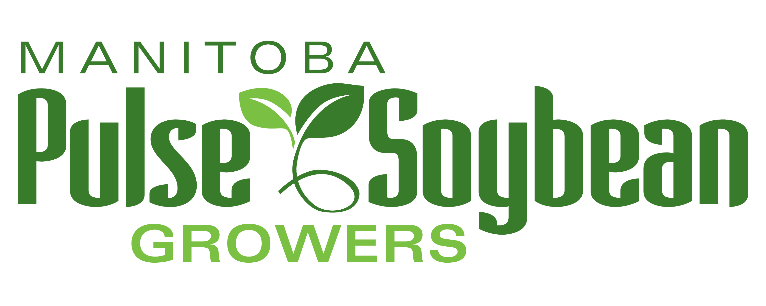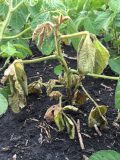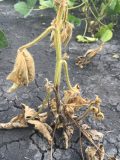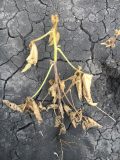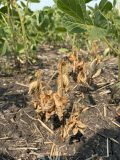About Phytophthora
Phytophthora root rot (PRR), caused by Phytophthora sojae, is a root and stem disease specific to soybeans. Unlike other root rot pathogens, PRR can infect soybeans at any development stage.
It is an oomycete pathogen, also called a water mould, that can remain dormant in the soil for at least four years. Infection of plants takes place via zoospores, which are attracted to root exudates and can swim to their host through water in the soil.
Symptoms and Scouting
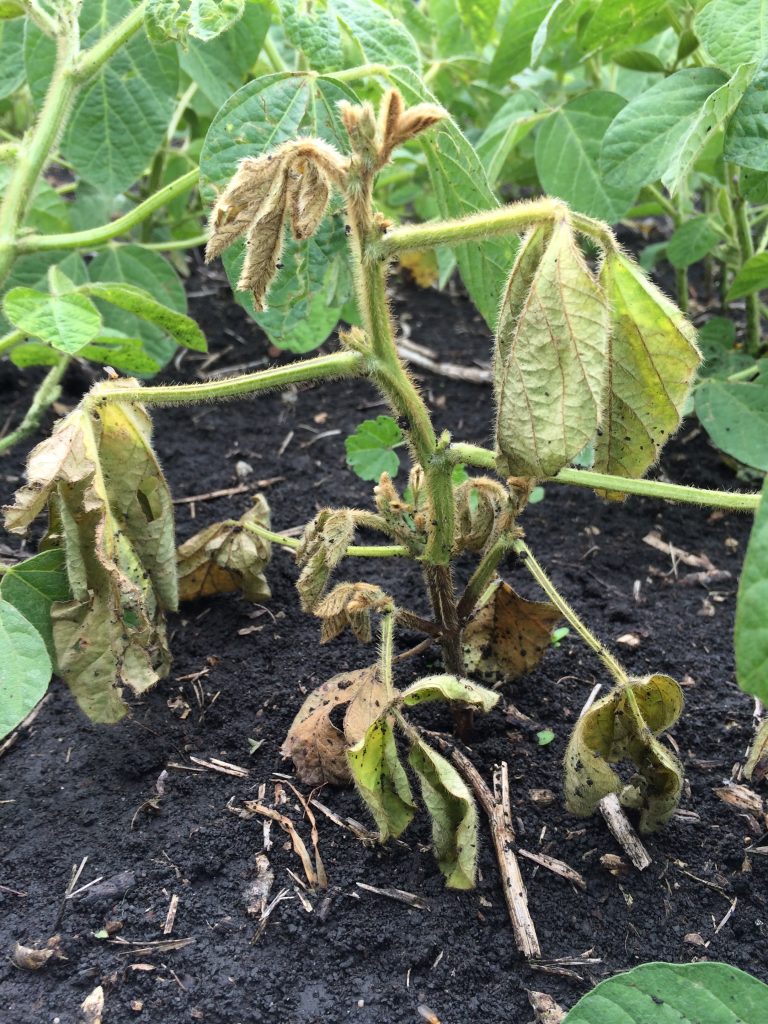
Late-season infection of PRR appears as a chocolate-brown lesion that extends upward from the soil line. In some cases, this lesion may develop up one side of the plant only. Dig up roots to confirm. If roots appear rotten (e.g., root mass is reduced and discoloured, nodulation is minimal), it is likely PRR. If a stem lesion is present and roots appear healthy, it may be another stem disease like northern stem canker or pod/stem blight. The internal cortex and vascular tissue of the stem will also have brown discolouration and plants will pull easily from the soil.
Other symptoms of PRR include stunting, yellowing plant tissue and wilted leaves that remain attached to the plant. Infected plants may occur in patches or at random among healthy plants.
Heavy, compacted and saturated soil is conducive to PRR infection. You will most likely find this disease in field approaches, drains and generally low-lying areas of the field. Warm soil and periodic rains will also increase the likelihood of infection.
Management
The best strategy to minimize the impact of PRR on soybean yield is to rotate to non-host crops (soybeans and lupins are hosts). A rotation of four years or more will help break up this pathogen’s life cycle.
The next best strategy is variety selection or host resistance. There are two types of variety resistance:
- Race-specific resistance – A single, dominant resistance gene to P. sojae (rps) resists infection within the plant. Plants with this type of resistance are protected from planting to harvest. However, plants may only be protected against certain races of PRR, depending on the variety/resistance gene used (Table 1). Rps genes that are currently available in soybean varieties in Manitoba include rps genes 1a, 1b, 1c, 1k, 3a and 6. Rps genes for currently-available soybean varieties can be found in the MPSG Pulse and Soybean Variety Guide or Seed Manitoba in the far right column of the variety description tables.
- Partial resistance (a.k.a., field tolerance, field resistance or quantitative resistance) – Multiple genes resist infection within the plant. This type of resistance is only expressed after the cotyledons and first true leaves open. Rather than being fully resistant to the disease, plants are better able to growth through and tolerate the infection. Less is known about the partial resistance of soybean varieties available in Manitoba. Testing initiated in 2023 is working to better independently evaluate partial resistance of soybean varieties.
Surveillance Results
Research on P. sojae is ongoing across Western Canada, led by Agriculture and Agri-Food Canada. Each year, MPSG staff participate in a soybean disease survey, through which plants suspected to have PRR are collected and submitted to the lab at AAFC-Brandon for testing.
In 2022, Phytophthora root rot was confirmed in 11% of fields surveyed. Fields sampled from 2020 – 2021 were negative for PRR. In 2019, only 5% of fields surveyed (4/83) tested positive for PRR. In 2018 and 2017, PRR was confirmed in 29% (28/96) and 35% (31/89) of fields surveyed, respectively.
In 2016, four races of PRR were initially identified in Manitoba. These included races 4, 25, 28 and 3, of which race 4 was the most common. In 2017, race 3 was not detected and race 25 was predominant. In 2018, a new pathotype was detected that is similar to race 25, but it instead has 1d resistance.
We expect more PRR races and pathotypes to be identified over time, as is the case in Ontario and the U.S. where soybeans have a longer history. Race-specific resistance is still a beneficial management tool, but partial resistance will become more important over time to combat numerous PRR races.
Table 1. Resistance to Phytophthora sojae (rps) genes currently available in Manitoba and the most predominant races/pathotypes present.
PRR Race Identification of Soils from Manitoba Fields
In 2022, agronomists piloted a commercial soil test from AYOS technologies to identify PRR pathotypes in 11 farmer’s fields with suspected PRR presence. Of those 11 fields where PRR was confirmed, 100% of fields had PRR pathotypes that overcame soybean Rps genes 1a and 1c. Rps genes 1k and 3a were defeated at 55% and 64% of fields tested, respectively, and Rps 6 was defeated at 27% of PRR-infected fields.
Soil tests to identify PRR pathotypes present in fields planned for soybeans will be an important tool to inform variety selection so farmers can choose effective Rps genes that are resistant to the PRR pathotypes present in a given field. In 2023, this race identification will be integrated into the annual soybean disease survey and a subset of On-Farm Network soybean fields to further our understanding on PRR race distribution in Manitoba.
Independent Assessment of Variety Field Tolerance to PRR
In 2022, MPSG piloted a commercial service to independently assess variety field tolerance (or partial resistance) to PRR. In the greenhouse, varieties are grown in a hydroponic system along with three established check varieties (a highly susceptible, highly resistant and a middle-of-the-pack resistant). Plants are flushed with a cocktail of PRR races to ensure any major-gene resistance is overcome and only partial resistance is being evaluated. In 2023, this evaluation has been expanded to the annual soybean variety testing program. Seed companies submitting their varieties into the field trial have the option to include their varieties as part of this testing. Expect results in fall 2023.
The Ontario Soybean and Canola Committee test varieties in the field for field tolerance to PRR annually at a site with clay soil infected with common races of PRR. Results from this program can be used as independent information on field tolerance of available soybean varieties as there is some overlap between MB and ON short-season varieties.
Contact us if you suspect PRR in your field, or if you are interested in volunteering your field for soybean disease survey efforts.
Additional Resources
Declining Sources of Resistance to Phytophthora Root Rot in Soybeans and How to Manage It – Pulse Beat Spring 2022 article by Geneviève Arsenault-Labrecque, Vanessa Tremblay, and Richard Bélanger, Université Laval
2022 Disease Prevalence and Management Tools – Pulse Beat Spring 2023 article by Laura Schmidt, MPSG
Status of Root Rot Diseases in Soybeans, Peas and Dry Beans in 2019 – Pulse Beat Spring 2020 article by Laura Schmidt, MPSG and Debra L. McLaren, Yong Min Kim and Robert L. Conner, Agriculture and Agri-Food Canada
Resistance to Phytophthora Root and Stem Rot in Soybean – Pulse Beat Summer 2019 article by Debra L. McLaren, Robert L. Conner, Yong Min Kim and Maria A. Henriquez, Agriculture and Agri-Food Canada
2017 Survey of Soybean Root Rot in Manitoba – Pulse Beat Spring 2018 article by Debra L. McLaren, Robert L. Conner, Yong Min Kim and Waldo Penner, Agriculture and Agri-Food Canada and Holly Derksen, Manitoba Agriculture
